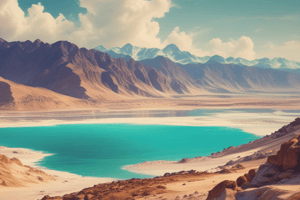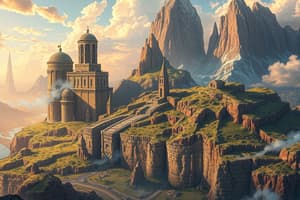Podcast
Questions and Answers
What are important physical features of various regions around the world?
What are important physical features of various regions around the world?
- The Great Barrier Reef, Sahara Desert, and Amazon River
- The Alps, Nile River, and Amazon Rainforest
- The Rocky Mountains, Appalachian Trail, and Mississippi River (correct)
- The Great Lakes, Andes Mountains, and Danube River
What are important factors to consider in population geography?
What are important factors to consider in population geography?
- Population density, population pyramids, and crude birth rates (correct)
- Political stability, government types, and military spending
- Economic development, international trade, and foreign aid
- Climate change, renewable energy, and technological advancements
What is culture?
What is culture?
- Shared practices, technologies, attitudes, behaviors, and taboos (correct)
- The study of animal behavior
- The study of rocks and minerals
- The practice of religion
What are important topics to consider in political geography?
What are important topics to consider in political geography?
What is environmental geography?
What is environmental geography?
What is an example of the impact of human activities on the environment?
What is an example of the impact of human activities on the environment?
What are important components of cultural geography?
What are important components of cultural geography?
What physical feature is not mentioned in the text?
What physical feature is not mentioned in the text?
Which of the following is NOT a factor to consider in population geography?
Which of the following is NOT a factor to consider in population geography?
What is the difference between ethnocentrism and cultural relativism?
What is the difference between ethnocentrism and cultural relativism?
Which of the following is not an international organization mentioned in the text?
Which of the following is not an international organization mentioned in the text?
What is the impact of human activities on the environment that is NOT mentioned in the text?
What is the impact of human activities on the environment that is NOT mentioned in the text?
What is the Aral Sea disaster?
What is the Aral Sea disaster?
What is the main topic of political geography?
What is the main topic of political geography?
Flashcards are hidden until you start studying
Study Notes
Geography Course Notes Summary
- The Rocky Mountains, Appalachian Trail, Mississippi River, Atacama Desert, Pampas, Pyrenees Range, Ural Mountains, Kalahari Desert, Nile River, Indus River, Huang He River, Ganges River, Himalaya Mountains, and Great Victoria Desert are all important physical features of various regions around the world.
- Population density, population pyramids, anti-natalist and pro-natalist policies, crude birth and death rates, natural increase rates, refugees, and remittances are all important factors to consider in population geography.
- Culture encompasses shared practices, technologies, attitudes, behaviors, and taboos, and can be understood through the concepts of ethnocentrism and cultural relativism. Language trees and ethnicity are also important components of cultural geography, as is the impact of globalization and cultural diffusion.
- Political geography involves understanding the concepts of statehood, nationalism, multinational states, and international organizations such as the United Nations, European Union, NATO, and NAFTA-USMCA. Gandhi and religious conflicts are also important topics to consider.
- Environmental geography involves understanding the impact of human activities on domesticated plants and animals, hybrids, fracking, non-renewable resources, strip mining, deforestation, tsunamis, earthquakes, and intensive and extensive agriculture.
- The Aral Sea disaster serves as an example of the impact of human activities on the environment and the consequences for individuals' lives.
Studying That Suits You
Use AI to generate personalized quizzes and flashcards to suit your learning preferences.




